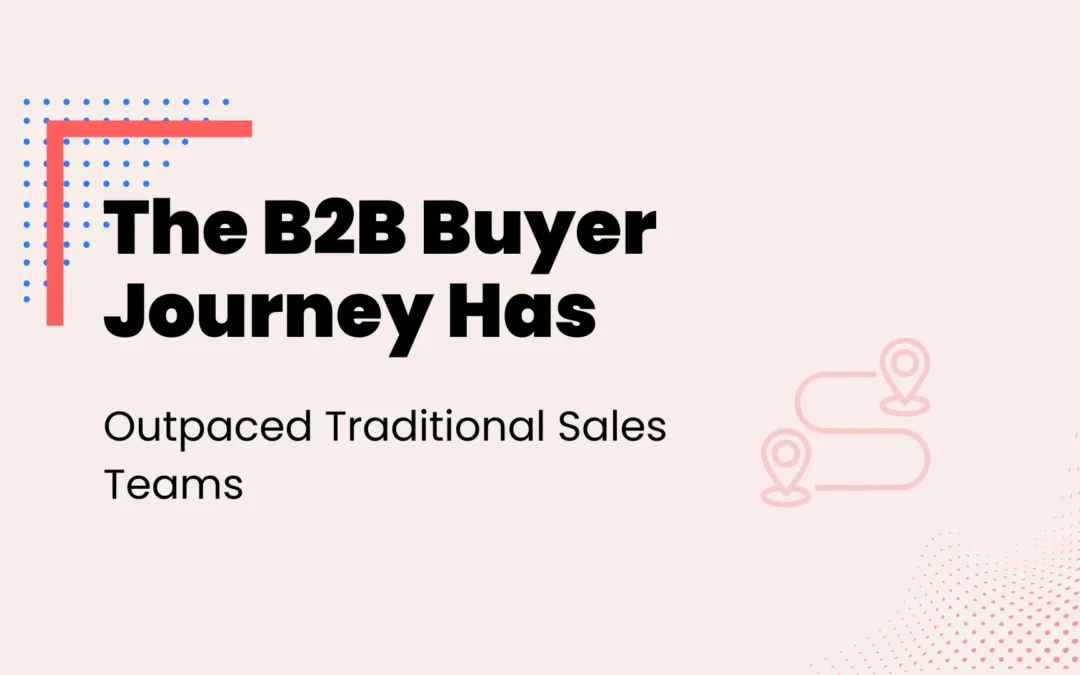B2B buyers now control the journey, researching and comparing solutions on their own terms. Traditional sales teams struggle to keep up. Discover how modern strategies can bridge this growing gap.
B2B Buyers Are Driving Their Own Journey
Modern B2B buyers are in control, often completing as much as 70% of their buying research before ever engaging a sales rep sellerscommerce.com. They prefer to self-educate by exploring websites, reading third-party reviews, and consulting peers across multiple channels. In fact, 75% of buyers today gather product information independently, and 57% have purchased a tool without ever meeting a salesperson blog.hubspot.com. By the time a buyer finally engages with sales, they are highly informed with clear expectations shaped by this extensive, omnichannel journey – a purchasing manager might spend weeks researching whitepapers, checking review sites, and asking peers on LinkedIn for recommendations before ever indicating interest to sales.
• Most buyers complete over half of the buying journey before contacting sales sellerscommerce.com.
• 75% of B2B buyers prefer self-service research, with many buying without any sales interaction blog.hubspot.com.
• Prospects use an omnichannel mix of websites, social media, and reviews to inform decisions.
Why Traditional Sales Struggle to Keep Up
Traditional sales development tactics are falling behind in the era of empowered buyers. Many sales teams still rely on cold calls and mass email blasts – generic outreach methods that today’s prospects increasingly ignore. Additionally, outdated lead generation strategies often focus on broad segments rather than using real-time intent data, meaning reps waste time on prospects with no current interest. Buyers’ inboxes and voicemails are already flooded with similar pitches, so one more generic sales email easily gets lost, or caught in spam filters due to low sender credibility, contributing to low response rates. In fact, 67% of reps reach out to 250 or fewer leads per year sellerscommerce.com and spend 72% of their time on non-selling activities sellerscommerce.com – no wonder traditional teams struggle to engage enough qualified leads in a timely way.
• Overreliance on cold calling and generic email campaigns yields diminishing returns for lead generation efforts.
• One-size-fits-all sales campaigns ignore buyer intent and fail to engage modern B2B leads effectively.
• SDRs have limited bandwidth, spending much of their time on admin tasks instead of active selling sellerscommerce.com.
AI and Automation Transforming Sales Development
AI for sales is emerging as a game-changer to close the gap between buyer and seller. Advanced AI sales tools analyze vast datasets – from firmographics to intent signals – to pinpoint high-potential prospects, then engage those leads with personalized outreach at scale. Unlike a human SDR, an AI SDR can run multiple tasks simultaneously – sending emails, scheduling follow-ups, and adjusting messaging based on real-time feedback – enabling a dramatic increase in pipeline without adding headcount. AI-driven platforms also optimize when and how to contact each prospect and ensure messages avoid spam filters, resulting in more qualified leads and meetings booked with greater efficiency. While AI systems can draft human-like outreach messages, they are meant to augment – not replace – the human touch, offloading tedious tasks so reps can focus on closing deals.
• AI sales tools rapidly qualify leads using intent data and analytics, improving lead qualification.
• Automation handles repetitive outreach and follow-up tasks across channels 24/7, boosting productivity for the sales team.
• AI-powered platforms personalize messages at scale and optimize timing, lifting engagement and lead generation results.
Reaching Buyers Through Omnichannel Engagement
In B2B sales, meeting buyers on their preferred channels is now a must. Modern B2B buyers often jump between their inbox, social media feeds, and third-party review sites sellerscommerce.com, and 77% say they prefer email outreach over calls sellerscommerce.com. This means a mix of email and other channels is crucial to reach them effectively. For example, a campaign might start with a personalized email, follow up with a LinkedIn message, and then surprise the prospect with a phone call or even a mailed gift – all timed for maximum impact. Coordinating across channels can be complex, but the payoff is huge: no single channel’s silence can stall your campaign or let a lead slip through the cracks when each touchpoint reinforces the others.
• Sales outreach spans email, LinkedIn, phone calls, and even offline methods to maximize reach to potential prospects.
• An omnichannel marketing strategy meets B2B buyers where they are most active sellerscommerce.com (in their inboxes, social feeds, etc.).
• Coordinated multi channel campaigns increase visibility and response rates compared to single-channel efforts.
Personalization and Intent: The New Imperative
In an age of inbox overload, generic sales pitches stand no chance – effective B2B lead generation now hinges on deeply personalized messaging and timing informed by buyer intent. Instead of blasting the same spiel to everyone, successful teams craft outreach tailored to each prospect’s industry, role, and pain point – highlighting the product benefits that matter most and mirroring the prospect’s own language. Using intent data is also critical: signals like content downloads or website visits reveal which prospects are actively interested. Armed with these insights, reps can reach out at the perfect moment with a personalized touch that addresses a real need. When outreach feels genuinely one-to-one, prospects feel understood rather than sold to – and they’re far more likely to respond and engage.
• Personalized emails and messages that speak to a prospect’s unique context truly stand out from “me-too” sales pitches.
• Buyer intent data lets sales teams prioritize hot leads and time outreach when buyer interest is peaking in the buying journey.
• Tailoring content and timing for each prospect boosts response rates and makes lead nurturing more effective over the long sales cycle.
Conclusion
Traditional sales methods can no longer keep up with empowered B2B buyers who demand timely, relevant, omnichannel engagement. Forward-thinking teams that leverage data, AI automation, and personalization are bridging the gap. By adapting to the buyer-led journey, sales organizations can transform this challenge into a lead generation advantage.
Adapting With Confidence
In this evolving landscape, solutions like GetReplies empower sales teams to keep pace with modern buyers. GetReplies provides an AI-driven SDR platform for outbound B2B lead generation that automates personalized, multi-channel sales campaigns using real-time intent signals. By handling targeting, outreach, and follow-ups at scale, GetReplies helps sales development teams engage the right B2B prospects at the right time with the right message. With advanced AI sales tools supporting their efforts, even traditional sales teams can adapt and thrive alongside today’s self-driven B2B buyers. The platform can even run hundreds of targeted micro-campaigns in parallel, ensuring no potential opportunity or segment is overlooked. By combining AI automation with a truly omnichannel marketing strategy, GetReplies takes the heavy lifting out of prospecting and pipeline generation, helping teams focus on high-value interactions that close deals.

